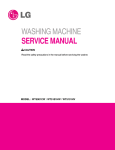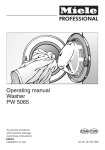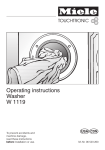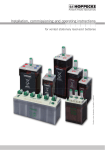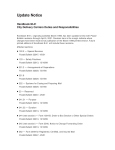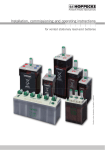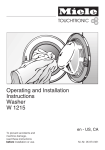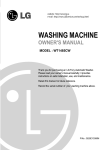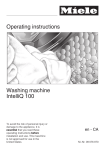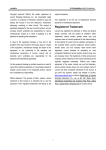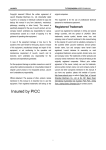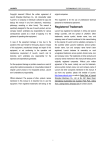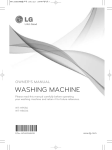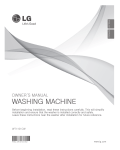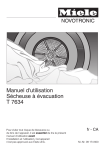Download WASHING MACHINE SERVICE MANUAL
Transcript
WASHING MACHINE SERVICE MANUAL CAUTION READ THIS MANUAL CAREFULLY TO DIAGNOSE PROBLEMS CORRECTLY BEFORE SERVICING THE UNIT. MODEL : 796.2927#0## SAFETY PRECAUTION! IMPORTANT SAFETY NOTICE! This service information is intended for individuals possessing adequate backgrounds of electrical, electronic, and mechanical experience. Any attempt to repair this appliance may result in personal injury or property damage. The manufacturer or seller can not be responsible for the interpretation of this information, nor can it assume any liability in connection with its use. WARNING: To reduce the risk of fire, electric shock, or personal injury when using this appliance, follow basic precautions, including the following: ·Disconnect this appliance from the power ·Wear gloves when working. supply before servicing. Turning the controls to Failure to do this can result in serious injury. ·The appliance is heavy. Two or more people is the off position does not disconnect this appliance from the power supply. required when moving the appliance. There is a risk of serious back injury or other injuries. Failure to do this can result in shock. ·Reconnect all grounded devices after servicing. ·Certain internal parts are intentionally not Failure to do this can result in shock. grounded and may present a risk of electric shock only during servicing. Service personnel Do not contact the following parts while the appliance is energized. : Pump bracket, rotor and heater To reduce the risk of fire, electric shock, or personal injury when using this appliance, follow basic precautions, including the following. CONTENTS 1. Specifications ............................................................................................................................. 3 2. Installation Instructions 2-1. How to Adjust Level .............................................................................................................4 2-2. Connerting Water Supply Hose .......................................................................................... 5 2-3. Connert the Drain Hose ...................................................................................................... 7 3. Operating Instructions 3-1. Identification of Parts .......................................................................................................... 8 3-2. Before Starting to Wash ...................................................................................................... 9 3-3. Function of Each Button .................................................................................................. 16 3-4. Washing Programs .......................................................................................................... 20 3-5. Care and Maintenance ..................................................................................................... 22 4. Service Information 4-1. Schemetic Diagram .......................................................................................................... 23 4-2. Wiring Diagram ................................................................................................................. 24 4-3. Program Time Chart ......................................................................................................... 25 4-4. Test Operation Without Water ........................................................................................... 32 4-5. Troubleshooting Methods for Common Washing Problems ............................................. 33 4-6. Troubleshooting Methods According to Error Message ................................................... 34 5. Exploded View ......................................................................................................................... 46 6. Replacement Part List .............................................................................................................. 50 2 1. SPECIFICATIONS Model 2927000 Electrical 120VAC@60Hz. Inner Tub Stainless Inlet Water Pressure 14.5 ~ 116 PSI (100 ~ 800 kPa) Rating of Fuse 125V, 12A for 100~127V/60Hz Spin Speed 1100 ±50 Weight 145.5 lbs (66kg) Cycles Normal/Casual, Cold Clean, Heavy Duty, Bulky/Bedding, Whitest Whites, Rinse/Spin, Kids Wear, Towels, Workout Wear, Colors, Express Wash, Handwash/Wool, Delicates Time Delay 1-19Hr Lid Interlock Switch Magnet Sensor Child Lock Yes Softener Dispenser Yes Detergent Dispenser Yes Bleach Inlet Yes Auto Power Off Yes Smart Rinse™ with Jet Spray Yes Heater Yes 3 2. INSTALLATION INSTRUCTIONS 2-1. HOW TO ADJUST LEVEL 1 Installation area 2 Set Leveling feet 3 • Install the washer on a firm, flat surface. • If the washer is installed on an unsuitable floor, it could make considerable noise and vibrate. 4 • Loosen the locknuts on 2 front leveling feet until you can turn the feet with the included wrench. Turn clockwise to raise the washer or counterclockwise to lower it. Raise Checking level • Open the lid, check if the washer is correctly leveled by looking down from the top. If a gap is seen between the tub and drum, the washer is not level. Checking slope • If installation surface is tilted, the washer will vibrate. Do not install on a sloping floor. Lower No shims. It would be dangerous. If the floor is that far from being level, it is a floor problem and not a washer problem. CAUTION • The ventilating openings in the base area must not be obstructed by carpeting. • Install the washing machine on a level and firm surface, and tilt should be less than 1˚ • Wooden floors may need reinforcing to prevent the normal vibration which occurs with an unbalanced load. • Do not install the washer on an inclined floor. Improper installation of the washer may cause noise and malfunctioning. 4 5 Horizontal setting 6 7 • Lift the front of the washer and adjust level by turnings the adjustable legs clockwise or using the adjusting plate. Raise Distance between the drain hose and the wall • Distance between the drain hose and the wall should be more than 4 inches (10 cm), and the distance between any other part and the wall should be more than 1 inches (2.5 cm) 45.13/32″ (115.3 cm) Lower Confirming level 1″ (2.5 cm) • Place the washer in original position, 27″ (68.6 cm) 1″ (2.5 cm) confirming the level. 55.13/16″ (141.7 cm) (with lid open) 28.13/64″ (72.1 cm) Do not install the washer in the following places. • Where the washer is exposed to direct sunlight. • Near a heater or heating appliance. • Where the washer is exposed to freezing temperatures. • In damp environments such as bathrooms or harmful environments. 5 4″ (10 cm) 2-2. CONNECTING WATER SUPPLY HOSE Before connecting the Water Supply Hose to the water tap, check the hose type and then choose the correct instruction here under. Screw Type 1 Attach the water supply hose to the tap. Push the water supply hose up so that the rubber packing within the hose can adhere completely to the tap. Water tap Rubber Seal Water Supply Hose 2 Connect the water supply hose to the tap. Connect the water supply hose to the tap and then tighten it by screwing it to the right. 3 Check water leakage. After connecting the hose, open the tap to check for any water leakage. Connecting Water Supply Hose to the machine Hot Cold • Connect the water supply hose to inlet valve of the washing machine, and then lock it by turning the hose connecting part. • Check to see if there is a rubber seal inside the connector. Water Hose (to water inlet on washer) Rubber Seal • A nwe washing machine should be instailed with new hoses. The old hoses shuld not be reused. Rubber Seal 6 Water Hose (to tap) 2-3. CONNECT THE DRAIN HOSE • Check that the drain hose is hung up over the edge of the laundry tub. • Do not use an extension hose. Cable Tie 39" (99 cm) • Attach the clip to the drain hose. And then push it toward the body of the washing machine as indicated by the arrow. 39" (99 cm) • Connect the drain hose to the outlet of the drain pump located at the rear of the washing machine. Cable Tie NOTE : • The drain hose should always be properly secured. Failure to properly secure the drain hose can result in flooding and property damage. • The end of the drain hose should be placed 39" (99 cm) from the floor. • The drain must be installed in accordance with any applicable local codes and regulations. • Make sure that the water lines are not stretched, pinched, crushed, or kinked. • Do not insert the drain hose more than 12” (30 cm) into the drain pipe to avoid siphoning and odor build-up. WARNING: • The washer should never be installed or stored in a location subject to freezing temperatures. If the washer was exposed to freezing temperatures prior to installation, allow it to stand at room temperature for several hours before use Damage to the water lines and internal mechanisms of the washer can result. • Water supply pressure must be between 14.5 psi and 116 psi (100 ~ 800kPa) If the water supply pressure is more than 116 psi, a pressure reducing valve must be installed. If you have uncontrolled water temperature and pressure you should fit a temperature and pressure relief valve to ensure that wate temperature and water pressure remain within the safe limits. Consult a plumber or electrician if you are unable to adjust water temperature and or pressure. Failure to do so can result in damage to the machine. • Plug the power cord of washer into a properly grounded outlet. Failure to do this can result in shock or serious injury. 7 3. OPERATING INSTRUCTION 3-1. IDENTIFICATION OF PARTS HOT WATER SUPPLY HOSE Powder detergent Box for delayed washing/softener additves box COLD WATER SUPPLY HOSE Make sure the water does not leak. TUB POWER PLUG If the supply cord is damaged, it must be replaced by the manufacturer or its service agents or similarly qualified person in order to avoid a hazard. INLET HOLE FOR BLEACH FUNCTION SELECTOR Clean regularly to stop linting on the clothes load. Multi Clean filter Washing Wing (unique with lnner Tub) DRAIN HOSE Be sure the drain hose is properly installed on the drain before operating the washer. BASE LEVELLING LEGS Use to level the washing machine for correct balance spin operation. 8 3-2. BEFORE STARTING TO WASH Care Labels • Look for a care label on your clothes. This will tell you about the fabric content of your garment and how it should be washed. Sort clothes into loads that can be washed with the same wash cycle, water temperature, and spin speed. Sorting To get the best results, different fabrics need to be washed in different ways. • SOIL (Heavy, Normal, Light) Separate clothes according to the type and amount of soil. • COLOR (Whites, Lights, Darks) Separate white fabrics from colored fabrics. • LINT (Lint producers, Collectors) Separate lint producers and lint collectors. Lint Producers Terry cloth, Chenille, Towels, Diapers Lint Collectors Synthetics, Corduroy, Permanent Press, Socks Check before Loading • Check all pockets to make sure that they are empty. Things such as nails, hairclips, matches, pens, coins, and keys can damage both your washer and your clothes. • Mend any torn garments or loose buttons. Tears or holes may become larger during washing. • Remove belts, underwires, etc. to prevent damage to the machine or your clothes. • Pretreat any dirt and stains. • Make sure the clothes are washable in water. • Check the washing instructions. • Remove any paper or tissue in the pockets. • WIRE WIRE Pretreatment on stains or heavy soil • Pretreat shirt collars and cuffs with a pre-wash product or liquid Detergent when placing them in the washer. Before washing treat special stains with bar soaps, liquid detergent or a paste of water and granular detergent. • Use a pretreat soil and stain remover. Treat stains AS SOON AS POSSIBLE. The longer they are left, the harder they are to remove. (For more detail refer to page 13) Loading WARNING Do not wash fabrics containing flammable materials(waxes, cleaning fluids, etc.). Fire Hazard Never place items in the washer that are Load Size dampened with gasoline or other flammable The WATER LEVEL should just cover the clothes. Adjust the load size fluids. accordingly. Loosely load clothes no higher than the top row of holes in the No washer can completely remove oil. washer tub. To add items after washer has started, press the Start button and Do not dry anything that has ever had any type submerge additional items. Close the lid and press the Start button again to restart. of oil on it (including cooking oils). ※ Do not wash waterproofed fabrics (such as skiing outfits, diapers, or nappy Doing so can result in death, explosion, or fire. auto seat covers.) Light and Large-sized clothing Clothes like downs and woollens are light weight, large and float easily. Use a nylon net and wash them in a small amount of water. If the laundry floats during the wash cycle, it may become damaged. Use dissolved detergent to prevent the detergent from clumping. ※ Do not wash water-proof textilles (Skling outfit, baby diaper, nappy automobile seat covers.) Long laundry items Use nylon bag nets for long, DELICATES items. For laundry with long strings or long length, a bag will prevent tangling during washing. Fasten zippers, hooks, and strings to make sure that these items don't snag on other clothes. ※ The nylon washing bag is not supplied by LG. 9 Using Water Water Temperature • The machine sets the appropriate temperature automatically according to the wash program . You can override the preset selection by pressing the WASH/RINSE temperature. button. • The temperature of the water impacts the effectiveness of all laundry additives and therefore, the cleaning results. • We recommend temperatures of: - HOT 120°F (120-140°F) White items, diapers, underclothing and heavily soiled, colorfast items. - WARM 90°F (85-105°F) Most items - COLD 66°F (65-75°F) Only very bright colors with light soil. • When washing in COLD water additional steps may be needed: - Adjust Detergent amount and pre-dissolve Detergent in WARM water - Pretreat spots and stains - Soak heavily soiled items - Use appropriate bleach * Temperature below 18°C (65°F) will not activate laundry additives and may cause lint, residue, poor cleaning, etc. In addition, detergent manufactures and care labels define COLD water as 26~29°C...(80-85°F). If the temperature of the water in the tub is too cold for your hands, the detergent will not activate and clean effectively. Note If iron is present in the water the clothes may become an all-over yellow or they may be stained with brown or orange spots or streaks. Iron is not always visible. Installation of water softener or an iron filter may be necessary for severe cases. 10 Using Detergent Detergent Follow the detergent package directions. Using too little detergent is a common cause of laundry problems. Use more detergent if you have hard water, large loads, greasy or oily soils or lower water temperature. Choosing the right detergent Your washing machine is designed for use with only High-Efficiency (HE) detergents. HE detergents are formulated specifically for Top-load washers and contain suds-reducing agents. Always look for the HE symbol when purchasing detergent. HE detergents produce fewer suds, dissolve more efficiently to improve washing and rinsing performance, and help to keep the interior of your washer clean. Using a regular detergent will cause unsatisfactory performance, oversudsing, machine build-up, and could damage the machine. Using the Liquid Bleach Dispenser The bleach dispenser automatically dilutes and dispenses liquid chlorine bleach at the proper time in the wash cycle. 1. Check clothing care labels for special instructions. 2. Measure liquid bleach carefully, following instructions on the bottle. • Never pour undiluted liquid chlorine bleach directly onto clothes or into the wash basket. • Do not pour powdered bleach into bleach dispenser. • Avoid overfilling or splashing when adding bleach to the dispenser. The maximum capacity of the bleach dispenser is one cup of bleach per wash cycle. Overfilling could result in premature dispensing of bleach. 3. Before starting the washer, pour measured amount of bleach directly into bleach dispenser. If you prefer to use powdered bleach, add it into the wash basket directly before adding clothes. WARNING: Do NOT mix chlorine bleach with ammonia or acids, such as vinegar or rust / scale remover. Mixing chemicals like these can produce irritating and toxic fumes. Put the manufacturer’s recommended amount of undiluted liquid chlorine bleach into the bleach dispenser. During the final portion of the wash cycle, two sequential flushes of the dispenser put all the bleach into the wash load and completely flush the dispenser to eliminate the carryover of bleach to a subsequent load. Any liquid remaining in the bleach dispenser at the end of the cycle is water, not bleach. To prevent unintentional self-siphoning of the bleach, never fill the dispenser higher than the maximum fill level marked on the dispenser. When adding bleach to the dispenser, be careful to avoid spilling it into the laundry load or leaving droplets of bleach around the dispenser. These things will damage your laundry items. 11 Using the Dispenser Drawer ABOUT THE DISPENSER The automatic dispenser consists of two compartments which hold: • Liquid fabric softener. • Liquid or powdered detergent. All laundry products can be added at once in their respective dispenser compartments. They will be dispensed at the appropriate time for the most effective cleaning. After adding the laundry products to the dispenser, close the dispenser drawer. Main Wash Main Wash Powder Detergent Liquid Detergent Compartment Compartment Liquid Fabric Softener Compartment To add detergent, bleach, and fabric softener to the automatic dispenser: ❶ Open the dispenser drawer. ❷ Load the laundry products into the appropriate compartments. ❸ Close the lid slowly and smoothly to avoid spilling, splashing, or premature dispensing of the contents. NOTE: It is normal for a small amount of water to remain in the dispenser compartments at the end of the cycle. NOTE: Do not use powdered or liquid bleach in the dispenser drawer. 12 Adding Detergent Add measured detergent to the detergent compartment of the dispenser drawer. • Do not exceed the maximum fill line. Detergent is flushed through the dispenser at the beginning of the wash phase. Either powdered or liquid detergent can be used, but the drawer insert must be removed to use powder. Detergent usage may need to be adjusted for water temperature, water hardness, size and soil level of the load. Avoid using too much detergent in your washer, as it can lead to oversudsing and detergent residue being left on the clothes. Adding Fabric Softener Pour the recommended amount of liquid fabric softener into the left-hand compartment. Use only liquid fabric softener. Dilute with water to the maximum fill line. • Do not exceed the maximum fill line. Overfilling can cause early dispensing of the fabric softener, which could stain clothes. NOTE: Do not pour fabric softener directly on the wash load. It may stain the clothes. Adding Wash Boost Additives The Wash Boost dispenser may be used to clean heavily soiled or stained garments more efficiently. If desired, place the additives for the wash boost setting in the right-hand compartment. Use only liquid additives. • Do not exceed the maximum fill line to avoid Overfilling can cause early dispensing of presoak additives, which could result in damaged clothes. NOTE : Do not pour additives directly on the wash load. It may stain the clothes. 13 Special Guide for Stain Removal WARNING Do not use or mix liquid chlorine bleach with other household chemicals such as toilet cleaners, rust removers, acid,or products containing ammonia. These mixtures can produce dangerous fumes which can cause serious injury or death. To reduce the risk of fire or serious injury to persons or property, comply with the basic warnings listed below: • Read and comply with all instructions on stain removal products. • Keep stain removal products in their original labeled containers and out of children's reach. • Thoroughly wash any utensil used. • Do not combine stain removal products, especially ammonia and chlorine bleach. Dangerous fumes may result. • Never wash items which have been previously cleaned in, washed in, soaked in or spotted with gasoline, dry cleaning solvents, or other flammable or explosive substances because they give off vapors that could ignite or explode. • Never use highly flammable solvents, such as gasoline, inside the home. Vapors can explode on contact with flames or sparks. For successful stain removal: • Remove stains promptly. • Determine the kind of stain, then follow the recommended treatment in the stain removal chart below. • To pretreat stains, use a prewash product, liquid detergent, or a paste made from granular detergent and water. • Use COLD water on unknown stains because HOT water can set stains. • Check care label instructions for treatments to avoid on specific fabrics. • Check for colorfastness by testing stain remover on an inside seam. • Rinse and wash items after stain removal. 14 Stain Removal STAIN TREATMENT Adhesive tape, chewing gum, rubber cement Apply ice. Scrape off excess. Place stain face down on paper towels. Saturate with prewash stain remover or nonflammable dry cleaning fluid. Baby formula, dairy products, egg Use product containing enzymes to pretreat or soak stains. Beverages (coffee, tea, soda, Pretreat stain. Wash using COLD water and bleach safe for fabric. juice,alcoholic beverages) Blood Candle wax, crayon Soak the item in a bowl of COLD water for at least 30 minutes. Then launder as usual. Remove all surface wax. Put the garment in the freezer for a couple of hours, then remove and break away as much wax as possible. Try a commercial removal product like Goo-Gone, Goop, or Go-Jo cleaner for the remaining wax stains. DO NOT ATTEMPT TO REMOVE WITH HEAT! Chocolate Pretreat or soak in WARM water using product containing enzymes. Wash using bleach safe for fabric. Collar or cuff soil, cosmetics Pretreat with prewash stain remover or rub with bar soap. Dye transfer on white fabric Use packaged color remover. Wash using bleach safe for fabric. Grass Pretreat or soak in WARM water using product containing enzymes. Wash using bleach safe for fabric. Grease, oil, tar (butter, fats, Scrape residue from fabric. Pretreat. Wash using hottest water safe for fabric. For heavy salad, dressing, cooking oils, stains and tar, apply nonflammable dry cleaning fluid to back of stain. Replace towels under stain frequently. Rinse throughly. Wash using hottest water safe for fabric. car grease, motor oils) Ink Some inks may be impossible to remove. Washing may set some inks. Use prewash stain remover, denatured alcohol, or nonflammable dry cleaning fluid. Mildew, scorch Wash with chlorine bleach if safe for fabric. Or, soak in oxygen bleach and HOT water before washing. Badly mildewed fabrics may be permanently damaged. Mud Brush off dry mud. Pretreat or soak with product containing enzymes. Mustard, tomato Pretreat with prewash stain remover. Wash using bleach safe for fabric. Nail polish May be impossible to remove. Place stain face down on paper towels. Apply nail polish remover to back of stain. Repeat, replacing paper towels frequently. Do not use on acetate fabrics. Paint, varnish WATER BASED Rinse fabric in cool water while stain is wet. Wash. Once paint is dry, it cannot be removed, OIL BASED AND VARNISH Use solvent recommended on can label. Rinse throughly before washing. Rust, brown or yellow discoloration For spots, use rust remover safe for fabric. For discoloration of an entire load, use phosphate Detergent and nonchlorine bleach. Do not use chlorine bleach because it may intensify discoloration. Shoe polish LIQUID Pretreat with a paste of granular detergent and water. Paste scrape residue from fabric. Pretreat with prewash stain remover or nonflammable dry cleaning fluid. Rub detergent into dampened area. Wash using bleach safe for fabric. 15 3-3. FUNCTION OF EACH BUTTON. POWER LOAD SENSING ¥ Power on. ¥ Push again, power goes off ¥Power goes off automatically after the wash is finished. ¥After turning the power on, the unit will automatically turn off if nothing is selected. ¥ It operates in all program. ¥During being detected by the sensor, the LOAD SENSING LED flashes. ¥It automatically sensing the quantity of laundries. ¥During this step, the washing machine select optimized washing algorithm. SOAK ¥ Gives additional soak time. WASH / RINSE ¥Select to select Water (Wash/Rinse) Temperature. ¥Pressing the button allows The selection of COLD/COLD ▶ WARM/COLD ▶WARM/WARM ▶HOT/COLD ▶ EXTRA HOT/COLD respectively. Default setting is Warm/Cold. SOIL LEVEL SPIN SPEED ¥Allows a selection to be make for the strength of the wash action. ¥Power option selections light up in sequence as follows Normal ▶ Heavy ▶ Light ▶ Normal as the button is pushed. This can be selected for any program. ¥Adjustment can be made while washing. ¥Default SOIL LEVEL is Normal. ¥Spin speed can be selected from No Spin to Extra high. Default is Low. (refer to page 24) SPECIAL USE ¥The following settings are indicated as the button is pushed SOAK ▶ SPIN ONLY ▶ RINSE+SPIN ¥Select COTTON/NORMAL, HEAVY/DUTY or TOWLES as the button is pushed SOAK ▶ STAIN CARE ▶ SPIN ONLY ▶ RINSE+SPIN Note The time shown on the display is the estimated cycle time. If the sensors and microprocessor elect to make changes during the cycle, the display will be adjusted accordingly. 16 EXTRA RINSE BUTTON ¥This includes an extra rinse cycle for a better rinsing action. DELAY WASH (Selection) BUTTON START/ PAUSE BUTTON ¥ Delayed finishing time. ¥ The time increases when the button is pushed. ¥ The following settings are indicated as the button is pushed 1 ▶ 2 ▶3 ▶ 4 ▶ ... 12 ▶ 14 ▶ 16▶ ▶ Reservation off ▶ 1 ... ¥ To cancel delay time, turn the power switch off or push DELAY WASH button until off. ¥Use to start or pause the wash cycle. Changes while be made to the wash settings while the machine is paused. ¥Repeats start and pause by pushing the button. CYCLE BUTTON ¥Use for selecting wash program. ¥This button allows the selection of 10 different programs for different kinds of laundry and dirtiness. ¥Program selections light up in sequence as follows: COTTON/NORMALA▶PERM PRESS CAUAL▶HEAVY DUTY ▶BULKY/BEDDING▶BRIGHT WHITE▶TUB CLEAN▶SANITARY ▶BABY WEAR▶TOWELS ▶SPORTS WEAR▶PURE COLOR ▶SPEED WASH▶WOOL ▶DELICATES Select the desired program by ressing the button. COLDWASH™ ¥Runs a cycle without hot water or the wash heater, For greater efficiency, we recommend washing a small load (less than 8 pounds) and a low spin speed. FABRIC SOFTENER ¥Causes the dispensing of fabric softener in the final rinse cycle. Custom Program BUTTON ¥This button allows you to store a customized wash cycle for future use . 17 BEEPER BUTTON CHILD LOCK FUNCTION ¥The beeper sounds at the end of the cycle. The clothing should be removed at that time to prevent the setting of wrinkles. ¥Touch the BEEPER button to cycle through the volume settings between OFF and high. ¥Use to lock or unlock the control buttons to prevent settings from being changed by a child. ¥To actuate or release the CHILD LOCK, press and hold the BEEPER button until the lock is turned ON or OFF. 3-4. WASHING PROGRAMS. (WT5101H*) 18 3-5. CARE AND MAINTENANCE When there is the possibility of freezing temperatures • Close the water taps and remove the water supply hoses. • Remove the water which remains in the water supply. • Lower the drain hose and drain the water in the sump and the drain hose by running a spin cycle. If frozen • Remove the water supply hose and immerse it in HOT water. (40° C or 104° F). • Pour approximately 2 liters (4½ pounds ) of HOT water (40° C or 104° F) into the sump and allow it ti stand for at least 10 minutes. • Connect the water supply hose to the water tap run a SPEED WASH cycle to confirm that the machine fills, drains, and operates properly. Wash Inner-Tub Inlet Hoses Exterior Long Vacations Leave the lid open after washing to allow moisture to evaporate. If you want to clean the inner-tub use a clean soft cloth dampened with liquid detergent, then rinse. (Do not use harsh or gritty cleaners.) Hoses connecting washer to faucet should be replaced every 5 years. Immediately wipe off any spills. Wipe with damp cloth. Avoid hitting surface with sharp objects. Be sure water supply is shut off at faucets. Drain all water from hoses if weather will be below freezing. Cleaning the inside of your washer If you use fabric softener or do regular COLD water washing, it is very important that you clean the inside of your washer occasionally as described below. • Fill your washer with HOT water. • Add 1 cup of bleach. • Let it operate for several minutes. • Stop the washer, open the lid, and leave it to soak overnight. • After soaking, drain the washer and run it through a normal cycle. Products that might damage your washing machine • Concentrated bleaches and diaper sanitizer will cause damage to the paintwork and components of your washer. • Hydrocarbon solvents, i.e. petrol, paint thinners and lacquer thinners, etc. can dissolve plastic and blister paint. (Be careful when washing garments stained with these solvents as they are flammable, DO NOT put them in washer or dryer.) • Some pretreatment sprays or liquids can damage your washer’s control panel. • Use of dyes in your washer may cause staining of the plastic components. The dye will not damage the machine but we suggest you thoroughly clean your washer afterwards. We do not recommend the use of dye strippers in your washer. • Do not use your washer lid as a work surface. 19 4. SERVICE INFORMATION 4-1. SCHEMETIC DIAGRAM 20 BK BL 21 HEATER Thermostat RD YL WH WH RD BL BL BL BN(BK) NOISE FILTER JET HOT BLEACH SOFTNER COLD SPRAY BL 6 1 2 3 4 5 GY BK BL YL BN OR BL(WH) GN/YL (GN) 1 2 2 1 1 RD WH BK YL GN/YL YL ATC 3 2 1 HALL SENSOR WH GY BN BL RD YL 1 2 3 BL RD YL 1 2 3 BL RD YL YL WH GY BL 3 2 1 DRAIN PUMP 1 2 CLUTCH MOTOR 1 2 3 BL BN WH BL 3 2 1 BL 1 2 3 BL 1 2 3 4 5 6 GY BL WH BN OVERFLOW SENSOR WH BK WH 1 2 1 2 3 4 WH BK YL MAIN PCB ASSEMBLY WH 1 2 3 PRESS S/W 2 1 3 S K Y 1 2 3 6 4 5 BN BL RD YL OR VL BL WH 6 1 2 4 5 3 1 2 3 WH GY YL WIRING DIAGRAM WH 1 1 2 3 4 5 6 7 8 CON2 1 2 3 4 5 6 7 8 BLUE BL SKY YL VL ※ WT5001CW dosen’t have PINK PK GN BROWN ORANGE BN OR BK RD GY WHITE BLACK WH LETTERS COLOR COLOR CODE part. SKY BLUE YELLOW VIOLET GREEN GYAY RED COLOR DISPLAY PCB ASSEMBLY 1 2 3 4 5 6 7 CON1 1 2 3 4 5 6 7 LETTERS DOOR LOCK 2 3 4 5 6 1 2 3 4 5 6 BK BN RD WH GY BL 4-2. WIRING DIAGRAM 4-3. DISASSEMBLY INSTRUCION ▶ Be sure to unplug the power to repair and replace electric parts. ESD (ElectroStatic DIscharge) WARNING Be sure to follow proper ESD and grounding precautions for diagnosis and repair. If this is not possible, touch the ground wire on a regular basis to remove any static charge built up on your person. 1) Remove front panel and main PCB assembly Rear Panel ① Remove 5 panel fixing screws attaching the panel on the back. ② Disassemble Rear Panel. Display PCB Main PCB ③ Pull the front panel forward. ④ Disassemble the protective cover. ⑤ Disconnect the leads from the controller. Protect cover ⑥ Remove 8 screws on the PCB assembly. ⑦ Disassemble PCB assembly. 22 2) Disassembly of the Noise Filter, Power Cord, Inlet Valve, Pressure Switch, and DT Housing. Noise Filter and Power Cord(Figure A) ① Remove the two screws attaching the noise filter. ② Disconnect 2 connector in Noise Filter and Disassemble Noise Filter and Power Cord. Inlet Valve (Figure B) ① Disconnect the leads from the inlet valve and remove three screws. ② Remove the hoses and output pipes from the input valve. ③ Remove the inlet valve. Pressure Switch (Figure C) ① Disconnect the leads from pressure switch and disassemble pressure switch ② Disconnect pressure tube from the pressure switch . DT Housing (Figure D) ① Remove the hoses and output pipes from the input valve. ② Disassemble the connector pipe and the DT housing. 23 3) Disassembly of Top Cover and Lid ① Insert a flat blade between the cabinet and the top cover to release the latches. ②Lift the top cover. ③Use the blade to push the left hinge out of the way and to displace the hinge pin to remove the lid. close open ④Remove the lid by pulling the right hinge pin out of its holder. 24 Inner Tub Cap Hub Fixing Nut Tub Cover Outer Tub Inner Tub Shaft Bearing Housing ASM Rotor Rotor Nut Inner Tub Cap Stator Hub Attachment Nut 4) Disassembly of Tub Cover and Pulsator ① Remove 8 screws and take off the tub cover. ② Remove the pulsator cap. ③ Remove the pulsator screws and take it out. ④ Remove the pulsator washer and take it out. 5) Assemble the service tool (38 mm wrench) 6) Remove the hub attachment nut. (38 mm) ① Hit the bar using the hammer. ② Disconnect hub fixing nut and disassemble the inner tub. 25 7) Disassembly of the Back Cover and Drain Pump ① Remove the screws that attach the back cover and take it off. ② Disconnect the leads and the drain hose from the drain pump. ③ Remove the pump attachment screws and the lead connector. Take the pump assembly out of the washer. 8) Disassembly of Damper Assembly ① Remove the top cover of the washing machine. ② As shown in the drawing, lift the damper assembly and remove it along with the outer tub assembly. ③ Damper assembly shall not be disassembled. Replace damper as assembly. 9) Disassembly of Rotor and Stator ① Use a wrench (M24) to remove the nut that connects the rotor to the shaft. (The torque should be 200 kgf/cm or 88 footpounds.) ② Remove the rotor by pulling it straight off the splined shaft. 26 ⑧ Remove the screws that secure the water guide. ④ Disconnect the hall sensor and stator connection before removing the stator in the subsequent step. ⑤ Remove the six screws securing the rotor. ⑥ Check the position of the snap ring, being cure it faces the rotor and stator. ⑦ To keep from dropping the stator, loosen the six bolts almost all the way; then hold the stator in one hand while removing the bolts with the other. ⑧ Be careful during removal and replacement to avoid cutting, nicking, or pinching any of the wires. This could cause a short or electrical noise in the machine. 27 ⑨ Remove four screws to release the tub bracket. ⑩ Remove 17 screws to release the bearing housing. Pull the housing away from the tub, but do not pry it with a screwdriver to avoid damage. 10) Disassembly of Door Lock Switch ① Remove the two door lock attachment screws. ② Remove the door switch and remove the attachment tube. 11) Disassembly of Heater ① Remove the three heater attachment screws. ② Loosen the nut at the middle of the heater to relieve the tension on the clamp. Then pull it out of the case. 28 4-4. 1 TEST RUNNING WITHOUT WATER 1) SAFETY CAUTION ·The main power board assembly has exposed live 120 VAC and live DC voltages. Use care when disconnecting connectors during troubleshooting and testing. (Wear electrostatic discharge gloves when handling the board. ·Unplug the power when handling the board assembly. (Wear electrostatic discharge gloves when handling the board. Store the board in an ESD [ElectroStatic Discharge] plastic bag.) 2) QC TEST MODE ·The washer must be empty and the controls must be in the off state. ·Press and hold the WASH / RINSE and SOIL LEVEL buttons; then press the POWER button. The buzzer will sound twice. ·Press the Start/Pause button to advance to the subsequent test mode step. Number of times the START/PAUSE button is pressed Check Pont Display Status None Turns on all LED T1 and Main Program Version 1 time Button Check T2 and Display Program Version 2 time None T3 3 time Inlet valve for Bleach Detergent turns on. (Cold Water) A and Water level frequency (1~10 Level) 4 time ※ On :67~33(26.7kHz~23.3kHz) Inlet valve for Softener Dispenser turns on. (Hot Water) ※ The meaning of 67~33 number is 26.7kHz~23.3kHz really B and Water level frequency (1~10Level) 5 time Inlet valve for J-Dispenser turns on. (Cold Water) C and Water level frequency (1~10Level) 6 time Heater check T4 and the coefficient of flood sensing 7 time Wave force check T5 and the coefficient of load sensing 8 time Drain pump check T6 and Water level frequency 9 time Pulsator operates for 3 minutes. T7 and the coefficient of load sensing 10 time High speed spin T8 and RPM 11 time Off . Unlocks the door . Turns off all LED None 29 4-5. TROUBLESHOOTING BY COMMON WASHING PROBLEMS Many washing problems involve poor soil and stain removal, residues of lint and scum, and fabric damage. For satisfactory washing results, follow these instructions. NOTE: NEVER use bar soap in the washing machine. WASHING PROBLEM Problems Solutions and Preventive Measures Possible Causes Poor soil removal ·Insufficient detergent ·Wash water temperature too low ·Incorrect wash cycle ·Laundry missorted ·Stains not properly pretreated ·Use correct amount of detergent for load size, amount of soil and water hardness. ·Use WARM or HOT water for normal soil. Different Water Temperature may be required according to soil type. (refer to page 12) ·Reduce load size. ·Wash with Heavy or Soak & Heavy wash cycle for heavy soiled laundry. ·Separate heavily soiled items from lightly soiled ones. ·Pretreat stain and heavy soil according to directions shown on page 11. Blue Stains ·Undiluted fabric softener dispensed directly onto fabric ·Pretreat the stain with detergent or a stain removal agent. ·Do not overfill fabric softener dispenser and do not pour liquid fabric softener directly onto fabric. See page 14 for more instructions. Black or gray marks on clothes ·A buildup caused by the interaction ·Keep the recommendations against Scrud (waxy buildup). of fabric softener and detergent ·Use correct amount of detergent for load size, soil level, can flake off and mark clothes and water Hardness. ·Not enough detergent Yellow or brown rust stains ·Iron or manganese in water supply, water pipes, or water heater ·To restore discolored load of whites, use rust remover safe for fabric. ·Install nonprecipitating water softener or an iron filter in your water supply system for an ongoing problem. ·Before washing, run water for a few minutes to clear lines. Lint ·Incorrect sorting ·Tissues left in pocket ·Overloading the washer ·Wash lint-producing items, like flannel sheets, towels, and the like separately from dark fabrics and fabrics that tend to collect lint. Remove all items, including tissues and papers, from the pockets of items to be washed. See page 11 for sorting information. ·Do not overload the washer Residue or Detergent ·Overloading the washer ·Undissolved detergent ·Excessive detergent ·Do not overload the washer. ·Some detergents need to be pre-dissolved, check the detergent instructions. Try pre-dissolving the detergent. ·Increase Water Temperature using HOT water safe for fabric. ·Use proper amount of detergent. ·Incorrect use of chlorine bleach. ·Unfastened zippers, hooks, buckles ·Ribs, tears and broken threads ·Overloading the washer ·Degradation of fabric ·Never pour chlorine bleach directly on fabric. See page 13 for adding liquid bleach. ·Fasten zippers, hooks, and buckles. ·Remove objects in pockets. See page 11 for caring before loading. ·Do not overload the washer. Holes, tears, or snags 30 4-6. TROUBLE SHOOTING METHODS ACCORIDNG TO ERROR MESSAGE ▶ For more detailed information for trouble shooting refer to page 42 to 51. ERROR WATER SUPPLY ERROR DECISION BASIS ·WATER LEVEL dose not rise to the set level in within 30 minutes. NO INLET lamp blinks DRAINAGE ·Water is not completely within 12 minutes. UNBALANCE ·Laundry unbalance during spin. LID OPEN ·LID is opened in the course of intermittent spin, normal spin or processing reservation. CAUSE FOR ERROR OCCURRENCE ·Water faucet is closed? ·Water supply is interrupted. ·Inlet V/V is clogged with dirts. ·Connector has bad contact to the inlet valve. ·BLUE 6-pin connector has a bad connection at the main board. REMEDY ·Open water faucet. Wait until water supply is resumed. ·Clean or replace filter. ·Correct the connector contact. ·Same as above. ·Is the drain hose located properly? ·Drain hose is folded or clogged due to freeze or dirt. ·Defective drain pump or the BLUE 3-pin connector to the main board has a bad connection. ·Drain hose properly positioned at 0.9 ~ 1.2 m (36 ~ 48 inches) above the floor. ·Make sure the drain hose is not plugged with a foreign object. ·Check drain pump motor contact. Replace the pump if necessary. ·Laundry in the INNER TUB is filled unevenly. ·Load the washer as evenly as possible. ·Washer is tilted. ·Adjust the leg. ·Lid is opened during intermittent spin or normal spin? ·Lid is opened while processing reservation? ·Check the connections to the lid switch and at the WHITE 6-pin connector at the main board. ·Close the lid. 31 ·Close the lid. ·Check the connections. ·If the connection is good, check the lead wire and replace it if necessary. ERROR ERROR DECISION BASIS CAUSE FOR ERROR OCCURRENCE PRESSURE ·Pressure switch has a ·Check the connections at the SENSOR bad connection or the pressure switch and at the switch has failed. BLUE 4-pin connector at the main board. ·Test the pressure switch in TEST MODE. If the initial reading is less than 60 or more than 104, the switch has failed and must be replaced. REMEDY ·Reseat the connector. ·Replace the switch. OVER FLOW ERROR ·Install the drain hose between ·Check the valves to be sure 0.9 ~ 1.2 m (36 and 48 inches) there is no input leakage. Then above the floor. check the drain hose and make sure the drain pipe is between ·Replace pressure sensor 0.9 ~ 1.2 m (36 and 48 inches) switch above the floor. ·Remove the foreign objects in pressure sensor switch ·Check for blockages and leaks in the air hose between the tub air hose. and the pressure switch. ·Check and repair any air leakages at the air hose connector on the outer tub and at any connecting parts. MOTOR ERROR ·Check the connections at the hall sensor and at the WHITE 6-pin connector on the main board. ·Check the connections at the stator and at the yellow 3-pin or WHITE 6-pin connector on the main board. Test the stator to determine it is not defective. ·Test hall sensor to determine it is not defective. ·Turn the drum to verify the bearings are not locked. 32 ·Replace the stator if necessary. ·Replace the hall sensor if necessary. ·Replace the bearings if necessary. 4-6. HOW TO DIAGNOSE AND REPAIR BY SYMPTOM 1) Washer is not energized. Where, what, and how to check Result of Check Possible Cause How to repair Household Power supply 1. Check the cord, plug, and outlet. Poor Electrical defect. Repair or replace as necessary. 2. Measure the voltage at the outlet. 120 VAC ± 10% No defect 0V Defect of household power supply Less than 1Ω No defect ∞Ω Open circult of the power supply cord Change the power supply cord. Call for power supply company Wiring of the Washer 1. Measure resistance between both ends of the power supply cord with both the plug pins short-circuited. 2. Check every connector for a loose connection. Male & female connectors separated Poor connection Unplug and re-insert the connector. 3. Check resistance of every wire to find out a open wire. ∞Ω Wire is opened. Change the lead wire Electrical component Less than 0.5Ω No defect 1. Check resistance with power relay switch turned on More than 1.0Ω Poor contact 2. Check the secondary voltage of the transfomer. 10~14 V No defect 0V Coil is open Replace the transformer. Open Blown fuse Note: US appliances are 120 VAC except for stoves, ranges, ovens, cooktops, and certain air conditioners. Change the fuse. CAUTION Check the fuse rating. 125 VAC 12 AMPS 3. Check for blown fuse. Change the AUTO OFF Switch Controller If all the components test good, the defect is likely the main control board. Over 120% voltage than rating check 33 Replace the main board if all the electrical components test good. 2) Defects on displaying funcion When, what, and how to check Result of Check Possible Cause How to repair Main voltage 1. Measure voltage at wall outlet. Expect 120 VAC ± 10%. If below 108 VAC, consult an electrician or your local power provider. Controller Low voltage If incoming line voltage is below 108 VAC, consult an electrician or your local power provider. Defective main board. Replace the main board. 1. Defective LED. 2. Defective LED driver circuit. 3. Defective Microprocessor. 3) Reset During operation When, what, and how to check Result of Check Possible Cause How to repair Less than 90% of the rating. Input voltage is too low or the house wiring is insufficient for the load. Consult an electrician. Noise or spurious signals are introduced to the controller through the power input. This could be caused by something outside the home. It is possible that a surge protector / line filter would help reduce the incidence. Main voltage 1. Measure voltage of the outlet that the washer is plugged into during wash and spin. 2. The reset event occurs at about the same time every day. 3. Check for line noise sources inside the house. Explain it is a problem of electric supply environment. Controller 1. If the input voltage is correct and the pump works properly, the main board is probably defective. Replace the main board. 34 4) Water doesn’t come into the wash tub. When, what, and how to check Result of Check Possible Cause How to repair Inlet Valve 1. If you hear the valve noise but get no water, check to see if the water is turned off outside the house. No water coming from taps. Water main turned off. Explain. 2) Check to see if taps are opened. Tap is closed. User error. Turn on the tap. 3) Hot and cold hoses are reversed. Incorrect installation. Incorrect installation. Reconnect hoses to correct taps. 4) Incorrect water temperature selected. Select correct temp. User error. Read and understand manual. 5) If items above check out OK, turn off the water, remove the hoses, and check the grit filters. Grit, sand, and foreign substances plugging filter. Normal sediment in water supply. Remove the filters, clean them with a small brush, and replace them. Water inlet valve(s) defective. Replace the inlet valves. Loose connection. Loose connection. Remove and replace the connector(s). ∞Ω Coil is open Replace the valve. 1. Does the display show a PE error code? PE Error displayed. Connector is loose, wire is broken, or the pressure switch is defective. Remove and replace the connector. If this does not resolve the issue, replace the pressure switch. 2. Use TEST MODE to read the frequency of the pressure switch while filling an empty washer. Less then 26.2 kHz Pressure switch is defective. Replace the pressure switch. 6) If everything checks out this far, check the vent hole in the pressure switch for blockage and make sure the plunger can move freely. 2. If the inlet valve fails (no clicking or buzzing) when the washer should be filling, check the connectors on each valve and at the main board. 2) Check resistance of the inlet valve. Pressure Switch Controller Replace the main board. 1. If the pressure switch and inlet valves test good, the problem is probably a defective main board. 35 5) Water fills continuously of intermittently When, what, and how to check Result of Check Possible Cause How to repair Wrong Installation/Leakage 1. Check to see that the drain hose is properly installed in a standpipe. Drain hose is fallen and lying on the floor. Incorrect installation. Install the drain hose in a standpipe that is between 36 ~ 46 inches (0.9 ~ 1.2 m) from the floor. 2. Figure where the leak is starting. Water leaks from a part. Defective part. Repair or replace the part. Pressure Switch No rotation. Water level is not detected. Check the pressure switch tube to verify it is not kinked, bent, blocked, or cut. Repair it as necessary. Detergent buildup or a foreign object is blocking airflow. Unstop it. 1. Verify the pulsator is rotating while water is filling the tub. 2. If the pressure switch tests good, verify the vent hols on the tub's air chamber is not blocked. Blocked. Inlet Valve Replace the valve. Inlet valve is defective. 1. Water comes in though the inlet valve even when the washer is unplugged. Water fills. Controller Replace the main board. 1. Water fills the washer immediately when the washer is turned on, even before pushing the START button. The triac has failed on the main board. 36 6) Display "LE" message and doesn't work When, what, and how to check Result of Check Possible Cause How to repair 1. LE error code appears. 1) Check the hall sensor, as shown. Brown DC 15V Black / (Ground) White Blue Red Hall sensor assembly In PCB assembly 2) Check resistance of the motor. Gray-White DC 15V Correct reading. OV Defective Gray - Red -Blue DC 12V Correct reading. OV Defective Replace the main board. Infinite resistance. The motor has an open coil. Replace the motor. Normal Resistance Normal condition. Motor is good. 37 Replace the main board. 7) Water does not drain. When, what, and how to check Result of Check Possible Cause How to repair Drain Pump 1. Can you hear the drain pump running? Yes Drain pump is blocked by foreign objects. NOTE: There is no place to do this. Please include the correct pump information for this machine. This is useless. 2. Check resistance between terminals if there is no working sound of the drain pump. ∞Ω The motor is open. Replace the pump. 3. If the motor tests good, check the connector. LEAVE BLANK Defective connector. Replace the main board. LEAVE BLANK Connector OK. Replace the main control board. Pinched, kinked, or mashed. Incorrect installation. Reinstall correctly. LEAVE BLANK Blocked hose. Unstop the hose and reinstall it so it is not kinked, pinched, or mashed. Drain Hose 1. Verify the drain hose is not pinched, kinked, or mashed. 2. Verify the drain hose is not clogged or obstructed. 8) Water drains, but at the wrong time When, what, and how to check PV asm 1. If water runs back into the machine after the drain cycle, inspect the pump's check valve to verify it is not obstructed by lint or foreign material. Result of Check Possible Cause How to repair Remove the blockage or foreign objects. Blockage in pump housing or drain bellows. Check valve and / or drain bellows deformed or damaged. LEAVE BLANK Replace the check valve and / or the bellows. These soft rubber parts may swell if contacted by petroleumbased products. The pump runs. Defective triac on main board. Replace the main board. Controller 1. Check to see if the drain pump or drain motor runs at power up (before the POWER button is pressed. 38 8) Water drains when it should not When, what, and how to check Result of Check Possible Cause How to repair Drain Hose 1. Verify the drain hose is inserted in a standpipe or drain that is 0.9 ~ 1.2 m (36 ~ 46 inches) above the floor. Discharge height incorrect. Incorrect installation. Insert the drain hose in a standpipe or drain that is 0.9 ~ 1.2 m (36 ~ 46 inches) above the floor. 9) Drain error (DE) is displayed even when water drains normally When, what, and how to check Result of Check Possible Cause How to repair Pressure Switch 1. In TEST MODE, check the pressure switch frequency with the tub empty. Below 26.3 kHz Defective pressure switch Replace the pressure switch. Between 26.3 and 27.1 kHz Defective main board Replace the main board. 10) Machine spins even with lid open When, what, and how to check Result of Check Possible Cause How to repair Lid Switch 1. Check resistance between both terminals on the lid switch with the lid open. Contacts of switch are welded. 0~9 Ω Change the lead wire assembly. Defective main board. Replace the main board. ∞Ω 39 11) Vibration, Noise or Unbalance Error happens during spin. When, what, and how to check Result of Check Possible Cause How to repair Using conditions such as installation etc. Not leveled. 2. Verify the load is not unbalanced, causing vibration and noise. Incorrect installation. Laundry is unbalanced. Level the washer. Rearrange items in the tub for a more even distribution. The pulsator rotates initially, then the inner tub rotates. Defective clutch. Replace the clutch spring ot the clutch assembly, as necessary. Oneor more of the suspension rods is defective. Replace all four suspension rods as a set. Be sure to get the rods in the correct positions. Suspension 1. Does the outer tub strike the top cover during a spin cycle when the washer is running empty? Yes ※ It is very important to determine the cause of any noise or defect in order to repair the problem correctly the first time. 12) Power turns ON or OFF by itself. When, what, and how to check Result of Check Possible Cause How to repair Noise on the power line. If the issue persists, contact the local power provider. Input voltage 1. This is usually caused by a spike or surge on the main power input to the house. 40 12) Power is automatically turned off during operation or immediately turning on the power button. When, what, and how to check Result of Check Possible Cause How to repair & settle Auto Power Relay or Controller 1. It would be defect of the controller if power is automatically tumed off immediately when turning on the power switch even though there is no defects in the power switch. Automatically tumed off Change the controller. 13) Sensor (1) Sensor failure Problems Result of Check Possible Cause ① Installation of a non-calibrated main board. ·If the value is not within 1~26 by checking the controller group. Recalibrate or replace the controller. ② Short ·Check the value of the sensor electrode by using TEST MODE during the operation of a normal operation *washing, rinsing, spinning, etc.) If the value shows no change, the sensor is defective. One of these should repair this. Clean the electrode of the sensor. Reset the sensor by entering and exiting the test mode. Check the wiring harness and connectors to the sensor. ③ The sensor is contaminated with a film of detergent, laundry additives, hard water scale, etc. ·The difference between the sensing value measured from the supplied water by a jig and the sensor value of the product is 5 or more. One of these should repair this. Clean the electrode of the sensor. Reset the sensor by entering and exiting the test mode. Replace the sensor. ④ Sensor is out of order ·tE - Temperature Sensor Fault Verify the operation of the temperature sensor in the QC test mode. Check the wiring harness. Replace the sensor. Replace the main board. ※ Stop or reset the sensor by entering and exiting the TEST MODE. 41 (2) Sensor inaccuracy Problems Result of Check How to repair ① Contamination on the sensor causes inaccurate readings. ·The difference between the sensing value measured from the supplied water by a jig and the sensor value of the product is 5 or more.. One of these should repair this. Clean the electrode of the sensor. Reset the sensor by entering and exiting the test mode. Replace the sensor. ② Inaccurate sensor readings. ·If the value measured from the jig is normal but the consumer is not satisfied with Reset the sensor by entering and exiting the test mode. ** - To set the sensor to detect a higher detergent level, increase the sensor group by 1 or 2 steps. - To set the sensor to detect a lower detergent level, decrease the sensor group by 1 or 2 steps. (See below.) (3) Changing the controller group Press and hold CUSTOM PROGRAM and DELAY WASH, then press the POWER button. ▶ Initial Test mode display: All LEDs are off, except I-SENSOR LED Display the number of TR calibration times: Display 0 means not calibrated, 1 for the first time and so on. 1. Press PROGRAM once. It will display the current controller group. (1 ~ 26) Press PROGRAM again to decrease the controller group by 1. 2. Press START / PAUSE once. It will display the current controller group. (1 ~ 26) Press START / PAUSE again to increase the controller group by 1. ※ The buzzer sounds if there is no controller group. 42 5. EXPLODED VIEW BODY-A BODY-B 43 5-1. EXPLODED VIEW OF TOP COVER ASSEMBLY A011 A056 A063 A061 A062 A240 A202 A050 A201 A200 A148 A180 A184 A390 A020 A183 A152 A186 A154 A153 A151 A147 A150 A241 A410 A105 A135 A230 A100 A190 A125 A380 HOT (RED) A275 COLD (BLUE) A276 A157 A140 44 5-2. EXPLODED VIEW OF OUT CASE ASSEMBLY F032 F015 F005 F004 F070 F002 F013 F012 F003 F000 F100 F011 F090 F026 F025 F150 F080 F020 F082 F027 F023 45 5-3. EXPLODED VIEW OF TUB ASSEMBLY K005 K000 K012 K021 K020 K030 K040 K050 K061 K060 K100 NATURAL K250 K350 K064 K170 K140 K345 K340 K200 K290 K351 K230 K210 K201 K410 K305 K430 K300 46 K400 K420 6. REPLACEMENT PART LIST 47 P/No.: MFL40322129

















































